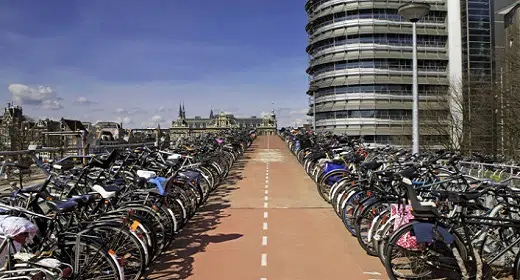by John Timmer: Lower emissions and lower obesity would more than offset the added traffic deaths…
Transportation produces about a quarter of the world’s greenhouse gas emissions, and passenger vehicles account for over half that figure. As such, nearly every plan for future emissions cuts includes some variant of getting people out of internal-combustion vehicles—typically into electric versions of the same vehicle. But a couple of countries have managed an alternate route to lower emissions: Denmark and the Netherlands both have bicycle-focused transportation that gets many people out of cars entirely.
An international team of researchers decided to look into what factors have enabled these countries to make that shift and what might happen if more countries adopted a similar transportation focus. Two conclusions are clear: It’s hard to get reliable data on bicycles, and bicycle-focused transportation could eliminate emissions equivalent to that of a decent-sized industrialized country.
How many bikes are there?
We have very good figures on the use of motor vehicles through government-required licensing and registration data. For bicycles, this is almost never the case, so the researchers had to estimate the number of bicycles present in most countries. To do so, they took figures on the manufacturing, import, and export and combined them in a model with information on how long bicycles typically last before being junked. The data runs up to 2015, so is already a bit out of date, as the pandemic has boosted cycling in many countries, but the countries they are able to make estimates for cover 95 percent of the global GDP.
Data on vehicle use isn’t available in every country. In some cases, it was estimated based on local data from within the country; in others, the estimate was derived from countries with similar demographics.
At least on sheer numbers, bicycles are far more prevalent than cars, with over 4.5 billion bikes produced since the 1960s, about 2.4 times the number of cars. Over half of these have ended up in just five countries: China, the US, India, Japan, and Germany, with China having nearly a quarter of the global bike total. Per capita, however, the numbers were quite different, with smaller, wealthy countries having the highest bike-to-body ratios. Places like Denmark, the Netherlands, and Norway all have more than one bike per person.
Overall, the researchers broke countries down into five categories. One of these categories included low GDP countries with few cars or bicycles. Another category, which includes China, Chile, and Brazil, comprised car ownership that grew rapidly but from a low level and bicycle ownership that grew slowly or not at all. A similar category included the same pattern but started from a higher level of ownership of both types of vehicles. This included places like Italy, Poland, and Portugal.
The category that included countries like Australia, Canada, and the US had high levels of ownership for both bikes and cars but tended to use the cars much more often. The researchers ascribed this in part to their “vast land areas.” Finally, the category comprising industrialized European countries was characterized as having very high bicycle ownership and stable levels of car ownership but with citizens who actually use their bicycles. Here, the authors suggest, “the basic transport needs are met already, and the pursuit for a more environmentally friendly and healthier life has driven the increase of bicycle ownership.”
There are some oddballs here. Some wealthy societies, like Japan and Switzerland, have lots of cars but a spectacular public transit system that lowers their use. Some wealthy European nations, like Norway, have weather and terrain that discourage widespread bicycle use. And a range of countries with high rates of traffic deaths, such as Brazil, Russia, and Thailand, also have low levels of cycling.
Overall, the conclusion from the basic analysis of ownership and use is that wealth and the right geography are both prerequisites for a cycling-focused culture. But they’re not guarantees that one will develop. That seems to require a societal-level choice to adopt this, along with a government willing to create the necessary infrastructure.
What ifs
Obviously, those pre-conditions aren’t even available to many countries; having them in combination with a willing society is even more rare. Nevertheless, we have good data on two clear examples: Denmark and the Netherlands. So, the researchers extrapolated the bicycle use of these countries to the rest of the world (2.6 daily kilometers per person in the Netherlands, 1.6 in Denmark).
Globally, adopting a Danish level of bicycle use would avoid the emissions of 414 million tonnes of carbon dioxide, approximately equivalent to the UK’s emissions in 2015. Boosting that to a Dutch level would avoid nearly 700 million tonnes, or most of the emissions from Germany that year.
The researchers also noted that countries like the Netherlands and Denmark have much lower rates of obesity than their peer countries. Based on the known health risks there, they estimate that, globally, we’re already avoiding 170,000 deaths annually due to the cycling. Expanding this globally, they found that Denmark-equivalent bicycle use would avoid 430,000 deaths per year. Dutch levels of cycling would avoid 780,000 deaths.
That said, the vulnerability of cyclists to cars poses its own lethal risks. But these aren’t anywhere close enough to outweigh the benefits from lower obesity. (They’d add about 90,000 and 160,000 additional deaths per year for the two levels of use.) And, if fewer drivers are using cars, there’s a chance that these numbers would come in even lower.
It seems worth noting that these estimates are definitely an underestimate of the benefits of shifting to bicycles. A typical bicycle will use far fewer resources to produce and will last longer than most cars. Maintenance is likely to be far less resource-intensive as well. So simply focusing on the use of the bike omits a lot of things that would show up in a detailed lifecycle analysis.
The researchers are certainly correct that there are a lot of locations where weather makes cycling a less-than-ideal option—and the range of places where heat makes it a positively dangerous option is expanding in our warmer climate.
But some of the other issues are less severe than they might appear at first. For example, the advent of bicycles with an electric assist means that hilly locales aren’t necessarily the barrier they might have been a decade ago. And, while a number of countries have large open spaces where cars are going to remain a necessity, the trend toward urbanization means that those same countries will have most of their citizens living in locations where cycling can be made an option.
So, the biggest barrier is likely to remain the social will to rethink transportation.
Source: Ars Technica

















































